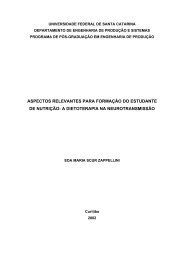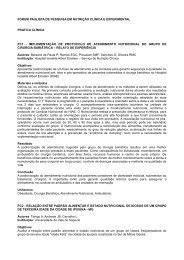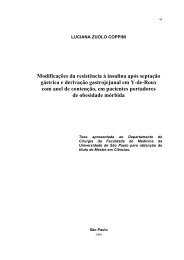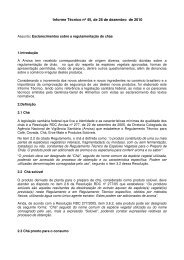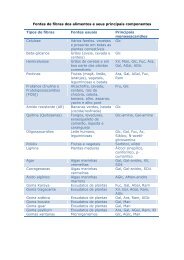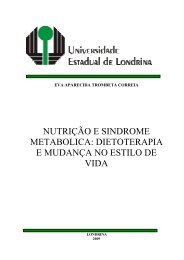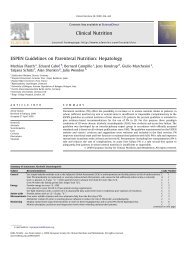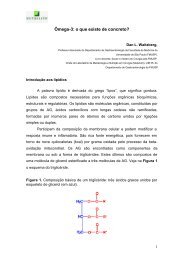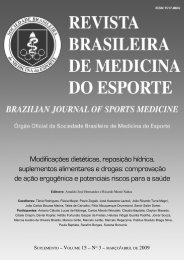Guidelines on food fortification with micronutrients - Nutritotal
Guidelines on food fortification with micronutrients - Nutritotal
Guidelines on food fortification with micronutrients - Nutritotal
- No tags were found...
You also want an ePaper? Increase the reach of your titles
YUMPU automatically turns print PDFs into web optimized ePapers that Google loves.
PREFACEwell. C<strong>on</strong>sequently in the l<strong>on</strong>g-term, measures for the preventi<strong>on</strong> and c<strong>on</strong>trol ofmicr<strong>on</strong>utrient deficiencies should be based <strong>on</strong> diet diversificati<strong>on</strong> and c<strong>on</strong>sumereducati<strong>on</strong> about how to choose <strong>food</strong>s that provide a balanced diet, including thenecessary vitamins and minerals.These guidelines are meant to assist countries in the design and implementati<strong>on</strong>of appropriate <strong>food</strong> fortificati<strong>on</strong> programmes as part of a comprehensive<strong>food</strong>-based strategy for combating micr<strong>on</strong>utrient deficiencies. Fortificati<strong>on</strong> of<strong>food</strong> can make an important c<strong>on</strong>tributi<strong>on</strong> to the reducti<strong>on</strong> of micr<strong>on</strong>utrientmalnutriti<strong>on</strong> when and where existing <strong>food</strong> supplies and limited access fail toprovide adequate levels of certain nutrients in the diet. To ensure that the targetpopulati<strong>on</strong> will benefit from a <strong>food</strong> fortificati<strong>on</strong> programme, an appropriate <strong>food</strong>vehicle must be selected that is widely c<strong>on</strong>sumed throughout the year by a largeporti<strong>on</strong> of the populati<strong>on</strong> at risk of a particular deficiency. In order to reach differentsegments of the populati<strong>on</strong> who may have different dietary habits, selectingmore than <strong>on</strong>e <strong>food</strong> vehicle may be necessary. Fortificati<strong>on</strong> of a staple <strong>food</strong>affects every<strong>on</strong>e, including the poor, pregnant women, young children and populati<strong>on</strong>sthat can never be completely covered by social services. In additi<strong>on</strong>,fortificati<strong>on</strong> reaches sec<strong>on</strong>dary at-risk groups, such as the elderly and thosewho have an unbalanced diet. Food fortificati<strong>on</strong> is usually socially acceptable,requires no change in <strong>food</strong> habits, does not alter the characteristics of the <strong>food</strong>,can be introduced quickly, can produce nutriti<strong>on</strong>al benefits for the target populati<strong>on</strong>quickly, is safe, and can be a cost-effective way of reaching large targetpopulati<strong>on</strong>s that are at risk of micr<strong>on</strong>utrient deficiency.However, there are limitati<strong>on</strong>s <strong>on</strong> the benefits of fortificati<strong>on</strong> and difficultiesin its implementati<strong>on</strong> and effectiveness. There may, for example, be c<strong>on</strong>cernsraised about the possibility of overdose or a reluctance to fortify <strong>on</strong> human rightsgrounds where c<strong>on</strong>sumer choice may be an issue. There may be reluctance <strong>on</strong>the part of the <strong>food</strong> industry to fortify out of fear of insufficient market demandfor fortified <strong>food</strong>s or c<strong>on</strong>cern about c<strong>on</strong>sumer percepti<strong>on</strong>s that the <strong>food</strong> producthas been altered. Food fortificati<strong>on</strong> also raises producti<strong>on</strong> costs through suchexpenses as initial equipment purchases, equipment maintenance, increased producti<strong>on</strong>staff needs and quality c<strong>on</strong>trol and assurance facilities. Ec<strong>on</strong>omicallymarginalised households may not have access to such <strong>food</strong>s and other vulnerablepopulati<strong>on</strong> groups, particularly children under five years of age, may not beable to c<strong>on</strong>sume large enough quantities of the fortified <strong>food</strong> to satisfy an adequatelevel of their daily requirements. All these issues need to be carefullyassessed and these are discussed in detail.This publicati<strong>on</strong> is a useful guide to assist decisi<strong>on</strong> makers in ensuring thatthe nutriti<strong>on</strong>ally vulnerable and at-risk populati<strong>on</strong>s benefit from <strong>food</strong> fortificati<strong>on</strong>programmes and FAO and WHO would like to express our thanks to allwho have been involved in this process. We reaffirm our support to achieve theMillennium Development Goals set by governments for overall nutriti<strong>on</strong>xix



